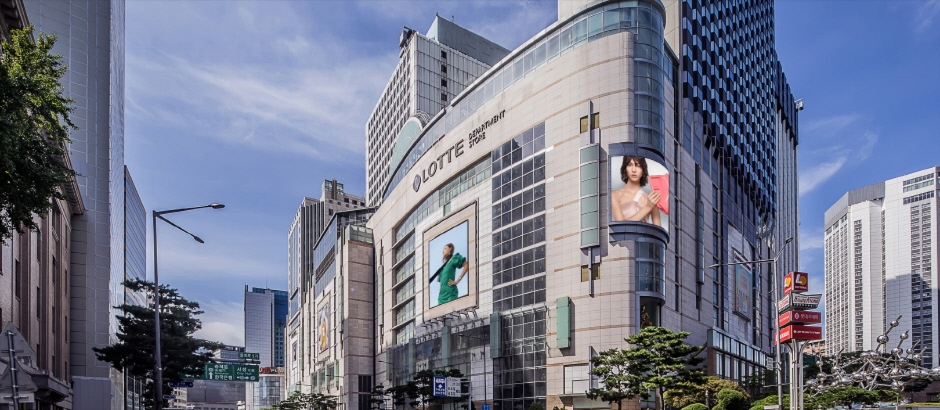Dior - Lotte Main Branch [Tax Refund Shop] (디올 롯데 본점)
6.6Km 2024-04-18
81, Namdaemun-ro, Jung-gu, Seoul
-
Lululemon - Lotte Main Branch [Tax Refund Shop] (룰루레몬 롯데 본점)
6.6Km 2024-04-23
3F, 81, Namdaemun-ro, Jung-gu, Seoul
-
Ralph Lauren Korea - Lotte Main Branch [Tax Refund Shop] (랄프로렌코리아 롯데지점)
6.6Km 2024-04-19
81, Namdaemun-ro, Jung-gu, Seoul
-
World Top Pharmacy - Lotte Main Branch [Tax Refund Shop] (월드탑약국 롯데본점)
6.6Km 2024-04-16
9F, 81, Namdaemun-ro, Jung-gu, Seoul
-
Lucenlee - Lotte Main Branch [Tax Refund Shop] (루첸리 롯데본점)
6.6Km 2024-06-26
81, Namdaemun-ro, Jung-gu, Seoul
-
Lf Hazzys - Myeong-dong [Tax Refund Shop] (LF(명동헤지스종합))
6.6Km 2024-04-19
28, Myeongdong 8ga-gil, Jung-gu, Seoul
-
LOTTE Department Store - Myeongdong Main Store (롯데백화점 (본점))
6.6Km 2024-05-17
81, Namdaemun-ro, Jung-gu, Seoul
+82-2-2200-0111
LOTTE Main store is the original branch of LOTTE Department Store, situated in the heart of Korea's bustling tourism hub, Myeong-dong. Shoppers can enjoy their time in the premium life-style shopping place with Luxury & Trendy brands.
Wangbijip (왕비집)
6.6Km 2024-03-11
26, Myeongdong 8ga-gil, Jung-gu, Seoul
+82-2-3789-1945
Wangbijip is a restaurant where all the meat is grilled by the staff. They focus on meats such as hanu galbisal (grilled boneless korean galbi) and sweet grilled marinated galbi. Popular lunch specialties include sogalbi jeongsik (grilled galbi set menu), bori gulbi jeongsik (barley-aged dried yellow croaker set menu), and dwaeji galbi jeongsik (grilled pork galbi set menu). The set menucomes with soybean paste jjigae and janchi guksu (banquet noodles) for a small serving. The lightly flavored janchi guksu is the best combination with the marinated galbi, giving it a light aftertaste.
BBQ CHICKEN Myeong-dong Star(BBQ치킨 명동스타)
6.6Km 2024-03-07
2F, 2 Myeongdong 4-gil, Jung-gu, Seoul
+82-507-1363-8810
BBQ CHICKEN Myeong-dong Star's signature dish is the Golden Olive Fried Chicken, which is fried in savory olive oil. The crispy batter and tender, savory meat are excellent. Patrons have other option to yangnyeom chicken (seasoned fried chicken), basak garlic chicken, or half and half. Ordering chicken legs and wings by cut is also a favorite. The best combination is with a cold beer.
The Handsome Tommy Hilfiger - Myeong-dong Branch [Tax Refund Shop] (한섬 타미힐피거 명동)
6.6Km 2024-04-18
11, Myeongdong 6-gil, Jung-gu, Seoul
-

![Lululemon - Lotte Main Branch [Tax Refund Shop] (룰루레몬 롯데 본점)](http://tong.visitkorea.or.kr/cms/resource/07/2890607_image2_1.jpg)
![Ralph Lauren Korea - Lotte Main Branch [Tax Refund Shop] (랄프로렌코리아 롯데지점)](http://tong.visitkorea.or.kr/cms/resource/26/2887926_image2_1.jpg)
![World Top Pharmacy - Lotte Main Branch [Tax Refund Shop] (월드탑약국 롯데본점)](http://tong.visitkorea.or.kr/cms/resource/35/2887935_image2_1.jpg)
![Lucenlee - Lotte Main Branch [Tax Refund Shop] (루첸리 롯데본점)](http://tong.visitkorea.or.kr/cms/resource/29/3313629_image2_1.jpg)
![Lf Hazzys - Myeong-dong [Tax Refund Shop] (LF(명동헤지스종합))](http://tong.visitkorea.or.kr/cms/resource/55/2878655_image2_1.jpg)

![The Handsome Tommy Hilfiger - Myeong-dong Branch [Tax Refund Shop] (한섬 타미힐피거 명동)](http://tong.visitkorea.or.kr/cms/resource/47/2888847_image2_1.jpg)
 English
English
 한국어
한국어 日本語
日本語 中文(简体)
中文(简体) Deutsch
Deutsch Français
Français Español
Español Русский
Русский